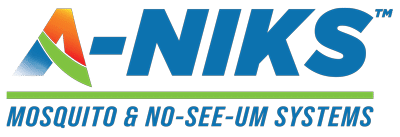Mosquito Control in Florida & the Southeast United States
Over the past 20 years, state and local authorities in the southeast United States have implemented various mosquito control strategies. What are these, how well did they work, what insecticides are used… All good questions as high season for mosquitoes is well underway in Florida, and folks who don’t have a spray service or a mosquito misting system operating on their property are severely hindered from using their outdoor space most of the morning and in the evening.
Mosquito control strategies
Among the most efficient ones deployed in the past 20 years: 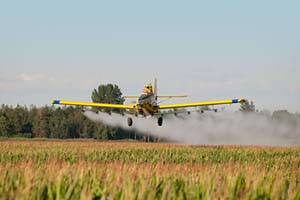 1. Aerial Treatments: In response to the detection of malaria in the southern United States, county officials in Florida have conducted aerial treatments to kill mosquitoes. This involves deploying airplanes and trucks to spray pesticides overnight, aiming to stem the spread of mosquito-borne diseases 2. Integrated Pest Management: An integrated approach to mosquito control has been successful in many areas. This approach involves a comprehensive strategy that includes removing mosquito habitats, using structural barriers, controlling mosquitoes at the larval stage, and controlling adult mosquitoes 3. Genetically Modified Mosquitoes: Genetically modified (GM) mosquitoes have been used to control Aedes aegypti mosquitoes, which transmit diseases like dengue, yellow fever, chikungunya, and Zika. These GM mosquitoes are designed so that the female offspring die before they become adults, reducing the overall mosquito population. 4. Vector Control Research: Ongoing scientific research and studies have focused on understanding the ecology and behavior of mosquito vectors to develop more effective control methods. This includes trials of insecticides, prevention of vector-host contact, and community engagement to enhance protective behaviors.
1. Aerial Treatments: In response to the detection of malaria in the southern United States, county officials in Florida have conducted aerial treatments to kill mosquitoes. This involves deploying airplanes and trucks to spray pesticides overnight, aiming to stem the spread of mosquito-borne diseases 2. Integrated Pest Management: An integrated approach to mosquito control has been successful in many areas. This approach involves a comprehensive strategy that includes removing mosquito habitats, using structural barriers, controlling mosquitoes at the larval stage, and controlling adult mosquitoes 3. Genetically Modified Mosquitoes: Genetically modified (GM) mosquitoes have been used to control Aedes aegypti mosquitoes, which transmit diseases like dengue, yellow fever, chikungunya, and Zika. These GM mosquitoes are designed so that the female offspring die before they become adults, reducing the overall mosquito population. 4. Vector Control Research: Ongoing scientific research and studies have focused on understanding the ecology and behavior of mosquito vectors to develop more effective control methods. This includes trials of insecticides, prevention of vector-host contact, and community engagement to enhance protective behaviors.
Pesticides used in aerial treatments for mosquito control
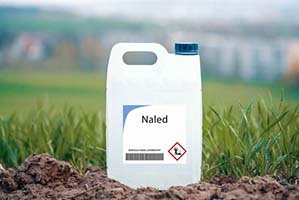
1. Anvil 10+10: Anvil 10+10 is an EPA-registered pesticide extensively tested and used in both ground-level and aerial spraying in the United States to control mosquitoes. It has been used in states like Florida and Massachusetts for aerial mosquito control.
2. Naled: Naled is another widely used pesticide in the United States for aerial mosquito control. It has been applied by aerial spraying to millions of acres per year within the mainland United States as part of routine mosquito control. Naled has been used in highly populated major metropolitan areas as well as agricultural and rural areas.
3. Permethrin: Permethrin is an insecticide synergized with piperonyl butoxide (PBO) that is used for adult mosquito control in some areas. It is dispersed from truck-mounted, ultra-low volume (ULV) aerosol generators. In Maryland, permethrin synergized with PBO is the principal insecticide applied for adult mosquito control. Note that all these pesticides are of the synthetic type. A-Niks prefers to use a proprietary natural blend of insect repellants to control mosquito populations on private and commercial properties. Our insecticide can be dispensed through a mosquito misting system, a regular garden watering system, and manually by technicians in the course of pest control spraying service.
Frequency of aerial spraying for mosquito control
It varies depending on the specific situation and the level of mosquito infestation. In situations where there is an elevated risk of human disease, state or local officials wil consider the use of an aerial pesticide spray in the evening and overnight hours to reduce the number of infected, adult mosquitoes in the specific areas of elevated risk. County officials in Florida have announced “aerial treatments” to kill mosquitoes after malaria was detected in the southern United States for the first time in 20 years. They deployed airplanes and trucks overnight to spray pesticides as part of an effort to stem the spread of the mosquito-borne diseases. The frequency of aerial adulticiding for mosquito management varies depending on the treatment frequency, location, life-stage targeting, and application techniques used. Spray trucks are sufficient for light mosquito populations, but aircraft are needed for moderate to heavy infestations and covering large areas quickly.
How efficient is the IPM approach to mosquito control?
The integrated pest management (IPM) approach to mosquito control is a comprehensive strategy that utilizes a variety of pest management techniques to prevent, reduce, and eliminate mosquito populations. The IPM approach has been found to work well in controlling local mosquito populations by a number of scientific studies:
- The University of Florida states that modern mosquito control for homeowners should be an IPM program that utilizes a combination of methods, with an emphasis on source reduction and eliminating areas where mosquitoes thrive. This approach involves actively participating in reducing mosquitoes around the home, which can help decrease pesticide use, reduce the risk of contracting mosquito-borne diseases, and ease the financial burden on local governments responsible for area-wide control. Our mosquito misting systems fit very well in this comprehensive approach.
- The U.S. Environmental Protection Agency (EPA) emphasizes that an integrated approach to mosquito control is the best approach. IPM takes advantage of every life stage of a mosquito and includes tactics such as removing mosquito habitats, using structural barriers, controlling mosquitoes at the larval stage, and controlling adult mosquitoes. Removing mosquito habitats and controlling mosquitoes at the egg and larval stages are generally the most effective and least costly methods. It is noteworthy that the EPA calls individual homeowners to pay attention to the areas on their property where water can accumulate: small basins, ponds, holes, decorative items, pools, buckets, tanks, etc.
- A study published in the National Center for Biotechnology Information (NCBI) highlights the importance of assessing the sensitivity of local mosquito populations to predict the efficacy of chemical pesticides used in mosquito control. This suggests that an IPM approach that considers local factors and population dynamics can lead to more effective control. A-Nicks belive in the use of natural insect repellants to decrease hyper local mosquito populations: some flowers and plantshave proven their repelling power for centuries: they worked yesterday and they work today. By comparison, synthetic insecticides produce over time a desensitization of the mosquito population to their chemicals, and therefore a decrease in their efficiency.
- The University of California Integrated Pest Management (UC IPM) program notes that many mosquito populations show significant levels of resistance to commonly used insecticides, highlighting the need for alternative control methods. This further supports the use of an integrated approach that combines multiple tactics for effective mosquito control. We recommend using certain plants and flowers in a garden and around a home to achieve better results, more naturally.
Pest management techniques used in IPM for mosquito control
- Surveillance: Surveillance is a critical component of IPM for mosquito control. It involves monitoring and keeping track of the numbers and types of mosquitoes in an area. Surveillance helps determine the need for control measures and guides decision-making.
- Source reduction: Source reduction aims to eliminate or modify mosquito breeding sites to prevent the development of mosquito larvae. This includes removing standing water, cleaning gutters, emptying containers, and maintaining proper drainage. All these measures can be efficiently implemented by homeowners and property managers to make their yards and properties more livable.
- Larvaciding: Larvaciding involves the application of larvicides to mosquito breeding sites to kill mosquito larvae before they develop into adults. Larvicides can be biological, such as Bacillus thuringiensis israelensis (Bti), or chemical-based.
- Adulticiding: Adulticiding is the targeted application of insecticides to control adult mosquitoes. This method is used when and if necessary, typically in response to high mosquito populations or disease outbreaks. Adulticiding is not the primary focus of IPM. Insecticides have to be used judiciously to avoid collateral damage (killing non-target insects) and hazards to .
- Resident education: IPM programs heavily rely on resident education to promote awareness and encourage individuals to take action in reducing mosquito populations. Education can include information on mosquito biology, breeding sites, personal protection measures, and the importance of source reduction.
- Structural barriers: Using physical barriers, such as window screens and mosquito nets, can help prevent mosquitoes from entering homes and outdoor living spaces, reducing the risk of mosquito bites.
Is there an ideal timing and frequency of misting for mosquito misting systems
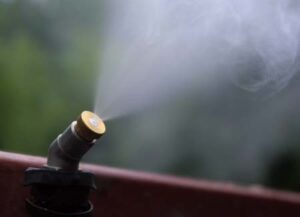 The ideal timing and frequency of misting for mosquito misting systems varies depending on the specific local situation and the level of mosquito infestation. Here are some guidelines used by A-Niks and some of our colleagues in the industry:
The ideal timing and frequency of misting for mosquito misting systems varies depending on the specific local situation and the level of mosquito infestation. Here are some guidelines used by A-Niks and some of our colleagues in the industry:
-
-
-
-
-
- Mist for 30-45 seconds, 2-3 times per night, depending on insect populations and time of year
- Set to spray for about 90 seconds, with this duration to be adjusted for different situations
- A few seconds to several minutes, and the misting frequency can be adjusted based on mosquito activity.
- Set the mosquito misting system timer to spray before noon and after 6pm. Spray at 6am and 8pm in the summer.
-
-
-
-
Among the factors impacting the timing and frequency of misting for mosquito control, let’s mention:
- Insect populations: The level of insect populations, particularly mosquitoes, impacts the frequency of misting. If mosquito populations are high, more frequent misting is necessary to effectively control them.
- Time of year: The frequency of misting depends on the season. Mosquito activity tends to increase during warmer months; more frequent misting is required during peak mosquito season.
- Local weather: Local weather conditions (temperature, humidity, rainfall) influence mosquito activity and the need for misting. Areas with higher temperatures and humidity (South Florida vs. North Florida) require more frequent misting to control the mosquito population.
- Surveillance data: Monitoring mosquito populations through surveillance activities can provide valuable information on the need for misting. If surveillance data indicates a significant increase in mosquito populations or the presence of mosquito-borne diseases, more frequent misting iswarranted. We use state guidance for this.
- Effectiveness of control: How effective is misting in controlling mosquito populations? If misting is proving to be effective in reducing mosquito numbers, the frequency will be adjusted accordingly. Our rule of thumb is the less insecticide we use, the better.
How do state and local authorities determine the insect populations in your area
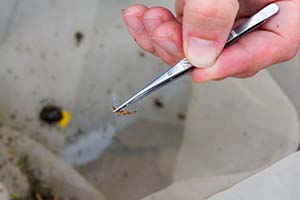 The State of Florida and local county authorities use various methods to determine the insect populations in your area. Here are some common techniques:
The State of Florida and local county authorities use various methods to determine the insect populations in your area. Here are some common techniques:
Sampling: Scientists collect a representative sample of insects from a specific area and count them. There are different sampling methods, such as sweep net sampling, sticky traps, and pitfall traps. The sample size and frequency of sampling vary depending on the specific situation and the level of insect infestation.
Mark-Release-Recapture Method: Scientists mark a subset of insects, release them back into the environment, and then recapture them at a later time to estimate the population size.
Direct Counts: Scientists count the number of insects in a specific area. This method is possible only with slow-moving insects and is not practical for all insect species.
Mathematical Models: Mathematical models are used to estimate insect populations based on trap catches and other experimentally measurable characteristics of an insect trap system. This method allows for a rigorous estimation of the most likely insect population density, along with the corresponding upper and lower bounds, from the number of insects caught by a single trap.
Visual Surveys: Scientists document the presence of a species or count the total number of individuals of each species observed during a standardized survey. This method is used to document the abundance and diversity of insects that can easily be visually identified in the field.
Obviously these methods are out of our reach, but we rely on the resulting publications and surveys to adjust our timings and frequency of misting and spraying.
Additional resources
Engineering a Mosquito Misting System
https://www.ncbi.nlm.nih.gov/pmc/articles/PMC5198204/
https://www.epa.gov/mosquitocontrol/success-mosquito-control-integrated-approach
https://www.cdc.gov/mosquitoes/mosquito-control/community/emerging-methods/genetically-modified-mosquitoes.html
https://www.epa.gov/mosquitocontrol/naled-mosquito-control
https://www.ncbi.nlm.nih.gov/pmc/articles/PMC155959/
https://edis.ifas.ufl.edu/publication/IN1045
https://vector.sccgov.org/programs-and-services/mosquitoes/mosquito-control-operations
